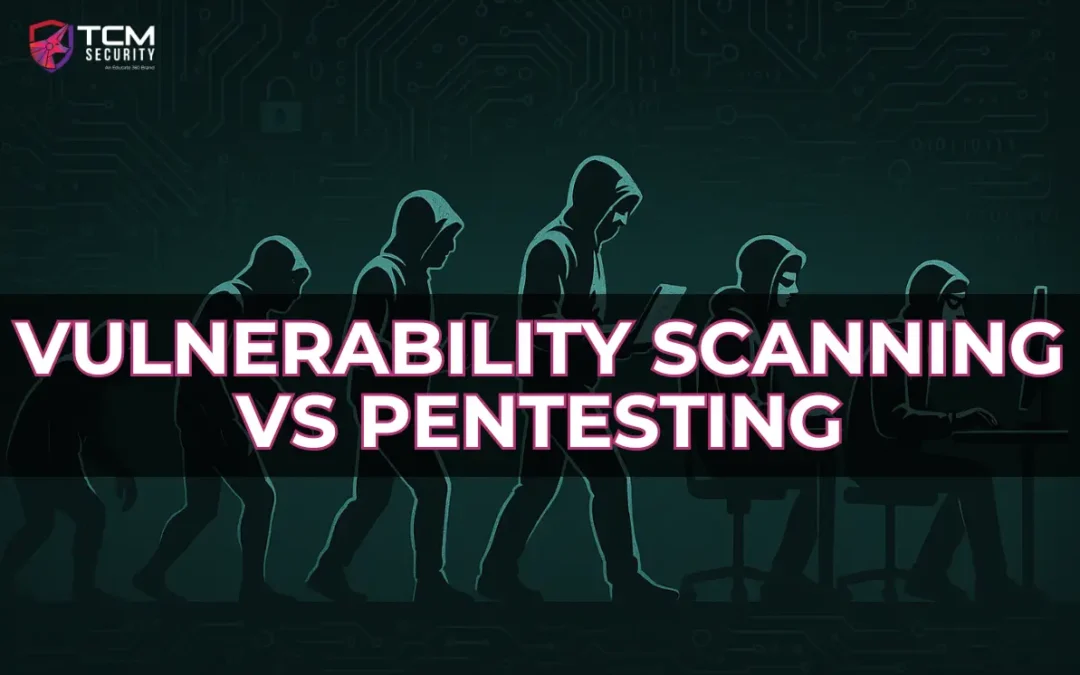Understanding that difference is key if you want to move from running automated tools to becoming a professional pentester who can think creatively and exploit vulnerabilities like a real adversary.
Defining the Concepts
A vulnerability scan could uncover weak access controls in your third-party HVAC control service, but a pentester can see that the lack of network segmentation between the HVAC system and the systems that collect customer payment card data is a problem that threat actors could use to say, exfiltrate a bunch of customer data.
Vulnerability Scanning
A vulnerability scan is an automated process that searches for known security issues across systems, networks, or applications. Think of it as a routine health check for your environment.
Scanners like Nmap, Nessus, OpenVAS, or Qualys crawl through assets to detect outdated software, missing patches, weak configurations, and known CVEs. They provide a list of vulnerabilities, their severity, and sometimes even remediation suggestions.
Because these scans are automated and repeatable, they’re often used continuously or on a regular schedule to maintain compliance and hygiene.
Penetration Testing
Penetration testing, on the other hand, goes far beyond detection; it’s about exploitation. Pentesters act like real-world attackers, manually probing systems, chaining vulnerabilities, and demonstrating how weaknesses could lead to compromise.
Rather than saying, “Here’s a known vulnerability,” a pentester says, “Here’s how I used that vulnerability to gain access to your network and exfiltrate data.”
It’s a blend of art and science where automation assists, but human creativity and attacker mindset lead the way.
There is a reason the MITRE ATT&CK framework is referred to as a ‘matrix’ and not a button. One vulnerability on its own is unlikely to bring about the compromise of a system, but a human noticing that the vulnerability can be used to pivot into another area of the system might.
Key Differences at a Glance
| Feature | Vulnerability Scanning | Penetration Testing |
| Purpose | Identify known vulnerabilities | Exploit vulnerabilities to assess real-world risk |
| Method | Automated | Manual and semi-automated |
| Depth | Shallow / detection only | Deep / exploitation, lateral movement, post-exploitation |
| Frequency | Continuous or scheduled | Periodic, project-based |
| Skill Level | Basic to intermediate | Advanced, creative attacker mindset |
| Tools | Nessus, OpenVAS, Qualys | Burp Suite, Metasploit, Cobalt Strike |
| Output | List of vulnerabilities | Attack narrative, impact analysis, remediation advice |
How They Work Together
A vulnerability scanner can show you that a door lock is capable of being picked, but a pentester knows how to pick the lock, crawl out the room’s window, and onto the next door balcony, into the next room where the safe is kept, and pick that lock as well, then repel down the side of the building with the loot.
Basically, a vulnerability scan is a tool that a pentester uses to find low-hanging fruit before starting an engagement on a network. It helps security teams keep track of known weaknesses, patch levels, and configuration drift.
Penetration testing validates and prioritizes those results by attempting real-world exploitation. A pentester can prove whether a “low-risk” finding could be chained into something far more dangerous.
Example:
- A scanner identifies an outdated Apache server version.
- A pentester tests whether that version can be exploited for remote code execution.
- If successful, the finding evolves from “medium” severity to a “critical” threat — backed by real-world proof.
Or Imagine this scenario:
A company runs a vulnerability scan that reports an open, low-risk port, nothing too alarming. But a pentester decides to dig deeper.
They discover that the open port exposes a management interface with default credentials. Once logged in, it allows remote command execution on the internal network.
Result: A “low-risk” issue escalated into full domain compromise.
That’s the difference: vulnerability scanners detect; pentesters demonstrate impact.
Common Misconceptions
Many new learners blur the line between scanning and testing. Let’s clear that up:
“A vulnerability scan is a cheaper pen test.”
– Not true. Scans are automated, broad, and compliance-focused. Pen tests are deep, manual, and risk-focused.
“Pen testers just use tools to find vulnerabilities.”
– False. Tools assist, but the real value comes from human logic, lateral thinking, and creative chaining.
“If a scanner finds nothing, the system is secure.”
– Dangerous misconception. Scanners miss unknown or misconfigured vulnerabilities that require human exploration to uncover.
Why Both Matter
Scanning teaches you automation, vulnerability databases, and the structure of enterprise security workflows. Scanning is an efficient method for finding the problems that we’ve already identified, but if something new comes along…
Penetration testing builds your hands-on exploitation, reporting, and attacker mindset. The scanner only knows what to look for because research has been done to find the issues and catalog them in a database, which the scanner is using. The research still needs to be done, and that is the job of penetration testers.
Learning Path
Start with vulnerability scanning:
Learn to use Nmap, Nessus, or OpenVAS to understand asset discovery and vulnerability enumeration.
Progress into manual testing:
Study Burp Suite, Metasploit, and scripting (Python, Bash, PowerShell). Learn how to validate and exploit vulnerabilities yourself. A hands-on course like the Practical Ethical Hacker is a good way to get started with manual testing.
Build real-world experience:
Use platforms like TryHackMe, Hack The Box, or VulnHub to practice chaining exploits and documenting results.
Pentesting Certification
If you want to learn some of the methodologies that go beyond vulnerability scanning and how to pivot from those initial access points into actionable findings that can impact an organization’s network security. TCM’s Practical Network Penetration Tester certification can prove you know how to use these methods as well as how to document them in a professional manner.
How To Get Started
To learn how to use vulnerability scanners as well as the methodologies for taking the next steps and really testing the systems. Intentionally vulnerable systems can be downloaded for practice from places such as Vulnhub and you can practice scanning with these with the aforementioned scanners such as NMap.
For penetration testing, you can learn the tactics and methodologies through courses, such as TCM’s Practical Ethical Hacker, and you can test or present these skills through hands-on certifications, such as the PJPT.
Good luck out there!
About the Author: Josh Daniels
Josh is an avid storyteller and writer who loves learning about the behind-the-scenes of the digital world we live in. While his professional experience is in content marketing, Josh began pursuing a career in cybersecurity in 2022, gaining a Sec+ certificate along with other training from industry professionals and a life long learner attitude.
When he is not writing, Josh enjoys outdoor adventures with his family, watching movies, reading, and an unofficial (unpaid) side gig as a Game Master Consultant for several friends who play table top RPGs. At TCM, Josh has found a home where his passion for storytelling and cybersecurity meet.
“Once men turned their thinking over to machines in the hope that this would set them free. But that only permitted other men with machines to enslave them.”
– Frank Herbert
About TCM Security
TCM Security is a veteran-owned, cybersecurity services and education company founded in Charlotte, NC. Our services division has the mission of protecting people, sensitive data, and systems. With decades of combined experience, thousands of hours of practice, and core values from our time in service, we use our skill set to secure your environment. The TCM Security Academy is an educational platform dedicated to providing affordable, top-notch cybersecurity training to our individual students and corporate clients including both self-paced and instructor-led online courses as well as custom training solutions. We also provide several vendor-agnostic, practical hands-on certification exams to ensure proven job-ready skills to prospective employers. Pentest Services: https://tcm-sec.com/our-services/ Follow Us: Email List | LinkedIn | YouTube | Twitter | Facebook | Instagram | TikTok
Contact Us: [email protected]
See How We Can Secure Your Assets
Let’s talk about how TCM Security can solve your cybersecurity needs. Give us a call, send us an e-mail, or fill out the contact form below to get started.

